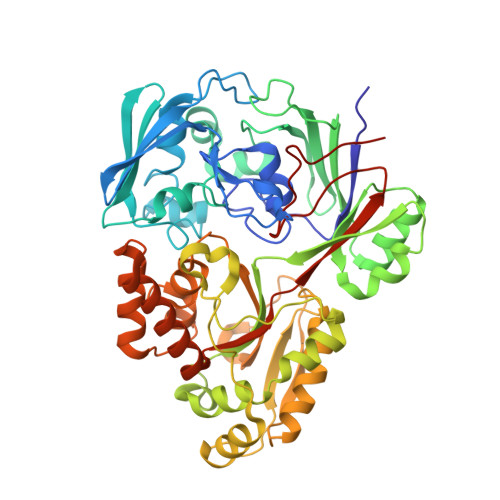A Pyranose-2-Phosphate Motif Is Responsible for Both Antibiotic Import and Quorum-Sensing Regulation in Agrobacterium tumefaciens.
El Sahili, A., Li, S.Z., Lang, J., Virus, C., Planamente, S., Ahmar, M., Guimaraes, B.G., Aumont-Nicaise, M., Vigouroux, A., Soulere, L., Reader, J., Queneau, Y., Faure, D., Morera, S.(2015) PLoS Pathog 11: e1005071-e1005071
- PubMed: 26244338
- DOI: https://doi.org/10.1371/journal.ppat.1005071
- Primary Citation of Related Structures:
4RA1, 4ZE8, 4ZE9, 4ZEB, 4ZEC, 4ZED, 4ZEI, 4ZEK - PubMed Abstract:
Periplasmic binding proteins (PBPs) in association with ABC transporters select and import a wide variety of ligands into bacterial cytoplasm. They can also take up toxic molecules, as observed in the case of the phytopathogen Agrobacterium tumefaciens strain C58. This organism contains a PBP called AccA that mediates the import of the antibiotic agrocin 84, as well as the opine agrocinopine A that acts as both a nutrient and a signalling molecule for the dissemination of virulence genes through quorum-sensing. Here, we characterized the binding mode of AccA using purified agrocin 84 and synthetic agrocinopine A by X-ray crystallography at very high resolution and performed affinity measurements. Structural and affinity analyses revealed that AccA recognizes an uncommon and specific motif, a pyranose-2-phosphate moiety which is present in both imported molecules via the L-arabinopyranose moiety in agrocinopine A and the D-glucopyranose moiety in agrocin 84. We hypothesized that AccA is a gateway allowing the import of any compound possessing a pyranose-2-phosphate motif at one end. This was structurally and functionally confirmed by experiments using four synthetic compounds: agrocinopine 3'-O-benzoate, L-arabinose-2-isopropylphosphate, L-arabinose-2-phosphate and D-glucose-2-phosphate. By combining affinity measurements and in vivo assays, we demonstrated that both L-arabinose-2-phosphate and D-glucose-2-phosphate, which are the AccF mediated degradation products of agrocinopine A and agrocin 84 respectively, interact with the master transcriptional regulator AccR and activate the quorum-sensing signal synthesis and Ti plasmid transfer in A. tumefaciens C58. Our findings shed light on the role of agrocinopine and antibiotic agrocin 84 on quorum-sensing regulation in A. tumefaciens and reveal how the PBP AccA acts as vehicle for the importation of both molecules by means of a key-recognition motif. It also opens future possibilities for the rational design of antibiotic and anti-virulence compounds against A. tumefaciens or other pathogens possessing similar PBPs.
- Institute for Integrative Biology of the Cell (I2BC), Department of Biophysics, Biochemistry and Structural Biology, CNRS CEA University Paris-Sud, Gif-sur-Yvette, France; Institute for Integrative Biology of the Cell (I2BC), Department of Microbiology, CNRS CEA University Paris-Sud, Gif-sur-Yvette, France.
Organizational Affiliation:




















